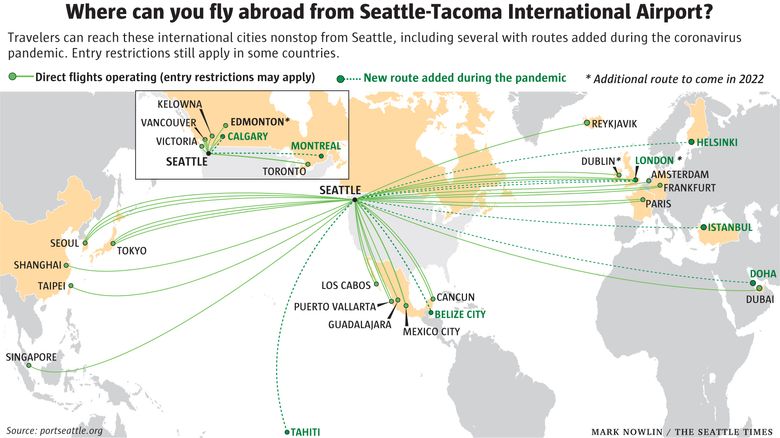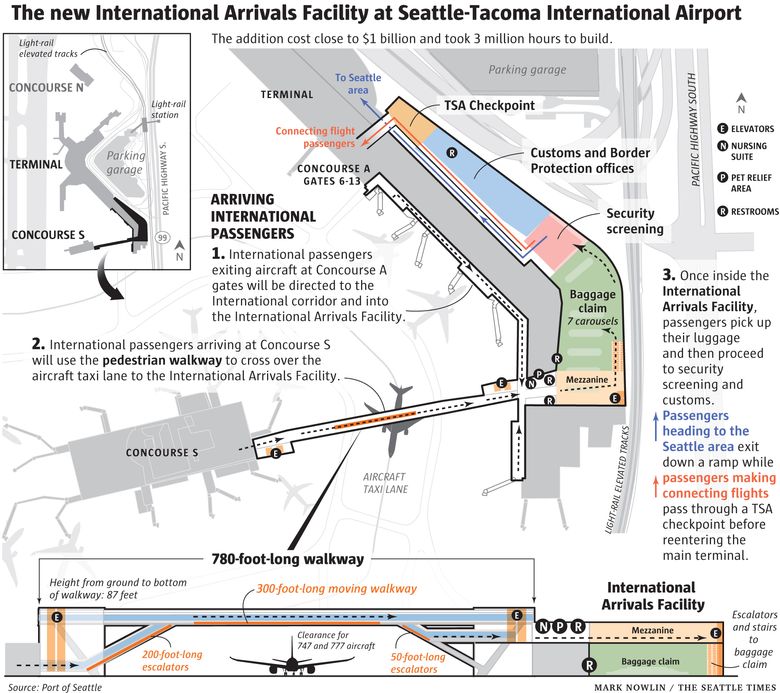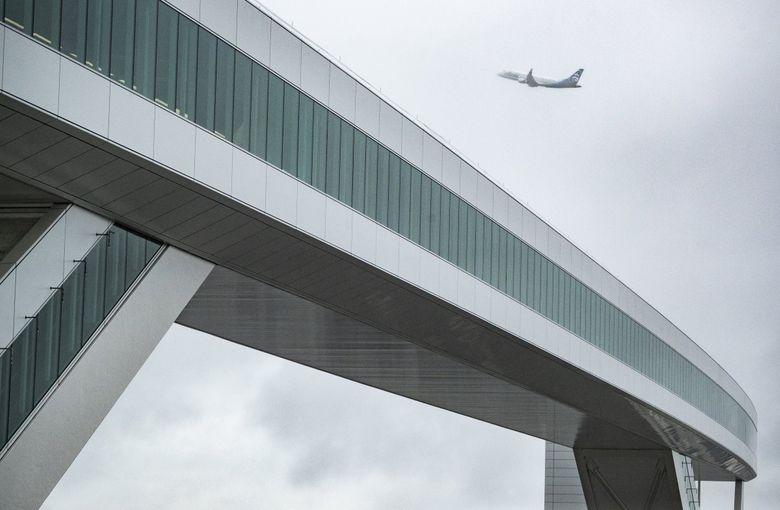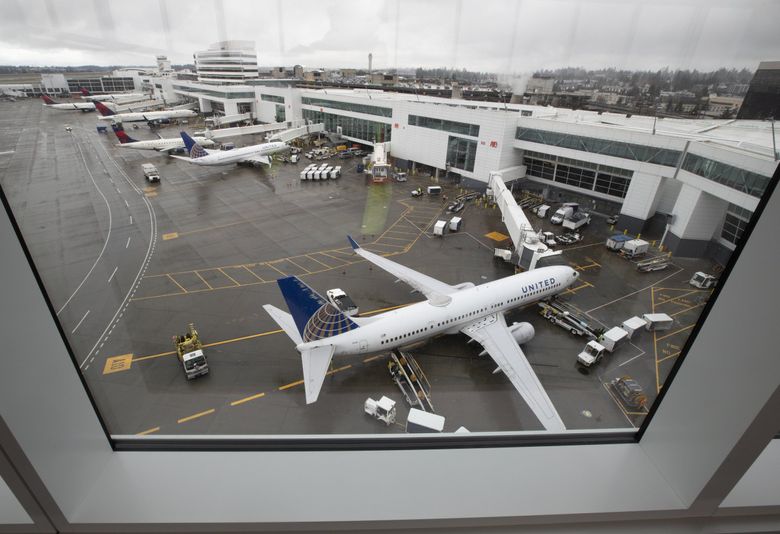The new International Arrivals Facility at Seattle-Tacoma International Airport welcomed its first passenger flight early Tuesday morning, signaling the start of the long-anticipated facility’s phased opening plan — and the beginning of a new era for international travel, airport officials say.
Passengers on Delta Air Lines flight 196 from Seoul’s Incheon International Airport taxied under the facility’s 780-foot long pedestrian bridge en route to their gate, where they received a water turret salute. Port of Seattle Commissioner Sam Cho says the facility opening marks “a huge milestone.”
With the loosening of pandemic-era travel restrictions like required masking, expanded service out of the airport and the new facility, it’s a whole new world at the airport for international travelers. Here’s a refresher on where you can fly abroad from Seattle, plus changes travelers should expect on their next visit to the airport.
New and familiar destinations
By this fall, 44 total international services will be in operation at the airport, with nonstop flights servicing 29 international destinations by 25 airlines. (In airline jargon, a service is one specific airline’s route between two destinations.) That’s up from pre-pandemic numbers of 42 services, 26 destinations and 22 airlines. As of April, 38 international services are in operation at the airport, with nonstop flights to 24 different international destinations.
Before the pandemic, the airport was one of the fastest-growing in the country, said Perry Cooper, the airport’s media relations manager. The pandemic depressed international travel by 79% in 2020 vs. 2019, but more services and passengers are returning to the airport, while other services have been discontinued. That includes the Norwegian Air shuttle to London’s Gatwick Airport, Cathay Pacific to Hong Kong, and Delta to Osaka, Japan. Other direct services to China have yet to return, in part due to federal agreements and restrictions.
Still, eight new international services, including five new airlines, have debuted or been announced at the airport over the last two years. Operating now: Qatar Airways to Doha; Alaska Airlines’ seasonal service to Belize; American Airlines to London; and WestJet service to Calgary, Alberta. Still to come: Turkish Airlines begins service to Istanbul in May; in June, Finnair will be flying to Helsinki; Air Canada goes to Montreal that month, too; and service to Tahiti via Air Tahiti Nui launches in October.
While London and Calgary, for example, added new airlines at destinations already serviced from Seattle, Belize, Helsinki, Doha, Montreal, Istanbul and Tahiti are all new destinations.
“For [airlines] to have confidence in this region and market shows the potential in business and leisure opportunities they see,” Cooper said. “It complements how fast our businesses are growing, particularly those with international connections, and highlights the diversity of our region as we continue to grow.”
In addition to new services at the airport, some services that had been lost to Seattle travelers are back. Virgin Atlantic resumed service to London in March; Alaska is resuming flights to Edmonton, Alberta, this month; Delta restarts service to London in May; and Aer Lingus will again fly to Dublin starting in July.
The international travel experience
It’s no coincidence that Seattle’s international travel options are expanding alongside the airport. Cooper says the new International Arrivals Facility will bring Seattle’s international travel experience into the future.
“This really brings us to where other airports are around the country,” Cooper said.
“Our facility was so outdated and cramped; we’ve been doing the best we can with the space we’ve got all these years. To finally get this open and have a positive experience for all our passengers is really exciting for us.”
On Tuesday, some flights deplaned from the A Concourse into the new facility. In early May, some flights arriving from the S Concourse will deplane to the facility via an aerial walkway, and starting May 10, all international arrivals will utilize the IAF.
As far as design, Cooper said customers can expect big changes.
“The difference in what people will see going into customs is unbelievably dramatic,” he said. “The No. 1 thing they are going to see is how much space there is — it’s more than four times the size of the old space. If you’ve been here before and you’ve been through the old, cramped space from the 1970s, it’s like walking into the modern day.”
The facility had a private reveal in March. In the coming weeks, the airport will test all operations before full opening. Overall, the airport says, travelers can expect shorter wait times, more international-capable gates, new amenities (more restrooms, a pet relief area and a nursing suite), and, hopefully, faster clearance through customs.
The 450,000-square-foot facility streamlines arrivals in several ways, chiefly by eliminating the need for a train ride. Previously, passengers arriving on an international flight went through customs control in the South Satellite, picked up their bags, then went through security again; connecting passengers went through another security checkpoint, while Seattle-bound travelers dropped off most of their bags to take a train to the main terminal, where they picked them up a final time before leaving the airport.
Seattle will be the first major airport to implement Customs and Border Protection’s “Bag First” process, in which travelers will pick up their bags before going to passport control. From there, connecting passengers will go through a Transportation Security Administration checkpoint to continue their travels while those whose trip ends in Seattle will go directly into the main terminal arrivals hall.
A window-lined pedestrian bridge spanning 780 feet — longer than the Space Needle is tall — will feed travelers from the S Concourse across the top of the A Concourse to the Grand Hall of the IAF. The escalator system used to reach the walkway is one of the 10 longest in the U.S. (including other airports, malls and subway stations), stretching 191 feet with 80 feet of rise.
Passenger capacity will more than double, to 2,600 travelers per hour, and baggage claim devices will service close to triple their previous volume. The new design brings the number of available international gates from 12 to 20 by making eight existing gates accessible for both domestic and international flights. These gates connect to a new security corridor for international arrivals, granting direct access to the IAF.
“A big thing in the industry is ‘connection time,’” Cooper said, referencing the time between touchdown and connection to your next flight’s gate. “Our goal is to reduce the minimum connection time from 90 to 75 minutes.”
From an aesthetic perspective, the new facility’s design welcomes the world in decidedly Northwest style. The Grand Hall grants views of Mount Rainier as natural light shines through floor-to-ceiling windows highlighting work by Indigenous artists. The environmentally friendly design meets LEED v4 certification specifications from the U.S. Green Building Council, and stained Douglas fir wraps the portals on either end of the facility.
The new facility at Seattle-Tacoma International Airport seems like a nice place to spend a layover. The airport is hoping you agree — but that you don’t have to wait too long.




